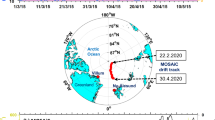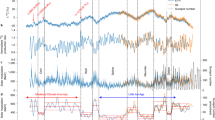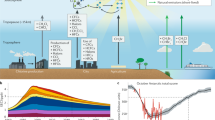Abstract
Measurements of trace gases in air trapped in polar firn (unconsolidated snow) demonstrate that natural sources of chlorofluorocarbons, halons, persistent chlorocarbon solvents and sulphur hexafluoride to the atmosphere are minimal or non-existent. Atmospheric concentrations of these gases, reconstructed back to the late nineteenth century, are consistent with atmospheric histories derived from anthropogenic emission rates and known atmospheric lifetimes. The measurements confirm the predominance of human activity in the atmospheric budget of organic chlorine, and allow the estimation of atmospheric histories of halogenated gases of combined anthropogenic and natural origin. The pre-twentieth-century burden of methyl chloride was close to that at present, while the burden of methyl bromide was probably over half of today's value.
This is a preview of subscription content, access via your institution
Access options
Subscribe to this journal
Receive 51 print issues and online access
$199.00 per year
only $3.90 per issue
Buy this article
- Purchase on Springer Link
- Instant access to full article PDF
Prices may be subject to local taxes which are calculated during checkout






Similar content being viewed by others
References
Montzka, S. A. et al. Decline in the tropospheric abundance of halogen from halocarbons: Implications for stratospheric ozone depletion. Science 272, 1318–1322 (1996).
Cunnold, D. M. et al. GAGE/AGAGE measurements indicating reductions in global emissions of CCl3F and CCl2F2 in 1992–1994. J. Geophys. Res. 102, 1259–1269 (1997).
Molina, M. J. & Rowland, F. S. Stratospheric sink for chlorofluoromethanes: Chlorine atom catalyzed destruction of ozone. Nature 249, 810–814 (1974).
Miller, J. M. Summary Report 1972(Rep. No. 1, Geophysical Monitoring for Climate Change, National Oceanic and Atmospheric Administration, Boulder, CO, 1974).
Prinn, R. G. et al. The Atmospheric Lifetime Experiment 1. Introduction, instrumentation, and overview. J. Geophys. Res. C 88, 8353 –8367 (1983).
Gamlen, P. H., Lane, B. C., Midgley, P. M. & Steed, J. M. The production and release to the atmosphere of CCl3F and CCl 2F2(chlorofluorocarbons CFC-11 and CFC-12). Atmos. Environ. 20, 1077–1085 ( 1986).
Fisher, D. A. & Midgley, P. M. Uncertainties in the calculation of atmospheric releases of chlorofluorocarbons. J. Geophys. Res. 99, 16643–16650 ( 1994).
Gribble, G. W. Natural organohalogens. J. Chem. Educ. 71, 907–911 (1994).
Khalil, M. A. K. & Rasmussen, R. A. Atmospheric methyl chloride. Atmos. Environ. 33, 1305 –1321 (1999).
Butler, J. H. Scientific uncertainties in the budget of atmospheric methyl bromide. Atmos. Environ. 30, R1–R3 (1996).
Penkett, S. A. et al. in Scientific Assessment of Ozone Depletion: 1994(eds Albritton, D. L., Watson, R. T. &Aucamp, P. J.) Ch. 10 (World Meteorological Organization, Geneva, Switzerland, 1995).
Lovelock, J. E., Maggs, R. J. & Wade, R. J. Halogenated hydrocarbons in and over the Atlantic. Nature 241, 194–196 (1973).
Isidorov, V. A., Zenkevich, I. G. & Ioffe, B. V. Volatile organic compounds in solfataric gases. J. Atmos. Chem. 10, 329–340 (1990).
Schwander, J. et al. The age of the air in the firn and the ice at Summit, Greenland. J. Geophys. Res. 98, 2831– 2838 (1993).
Sturges, W. T., Penkett, S. A., Barnola, J.-M. & Chappellaz, J. A. in Chemical Exchange between the Atmosphere and Polar Snow(eds Wolff, E. W. &Bales, R. C.) 617–622 (Springer, New York, 1995).
Battle, M. et al. Histories of atmospheric gases from the firn at South Pole. Nature 383, 231–235 (1996).
Elkins, J. W. in Summary Report 1994–1995(eds Hofmann, D. J., Peterson, J. T. &Rosson, R. M.) 84–111 (Rep. No. 23, Climate Monitoring and Diagnostics Lab., US Dept of Commerce, Boulder, 1996).
Butler, J. H. et al. in Summary Report 1996–1997(eds Hofmann, D. J., Peterson, J. T. &Rosson, R. M.) 91–121 (Rep. No. 24, Climate Monitoring and Diagnostics Lab., US Dept of Commerce, Boulder, 1998).
Schwander, J., Stauffer, B. & Sigg, A. Air mixing in firn and the age of the air at pore close-off. Ann. Glaciol. 10, 141– 145 (1988).
Bender, M. L., Sowers, T., Barnola, J.-M. & Chappeallaz, J. Changes in the O2/N2ratio of the atmosphere during recent decades reflected in the composition of air in the firn at Vostok Station, Antarctica. Geophys. Res. Lett. 21, 189– 192 (1994).
Craig, H., Horibe, YT. & Sowers, T. Gravitational separation of gases and isotopes in polar ice caps. Science 242, 1675– 1678 (1988).
Sowers, T., Bender, M. & Reynaud, D. Elemental and isotopic composition of occluded O 2and N2in polar ice. J. Geophys. Res. 94, 5137–5150 (1989).
Martinerie, P., Raynaud, D., Etheridge, D. M., Barnola, J.-M. & Mazaudier, D. Physical and climatic parameters which influence the air content in polar ice. Earth Planet. Sci. Lett. 112, 1–13 ( 1992).
Lovelock, J. E. Methyl chloroform in the troposphere as an indicator of OH radical abundance. Nature 267, 32 (1977 ).
Singh, H. B., Salas, L. J., Shigeishi, H. & Scribner, E. Atmospheric halocarbons, hydrocarbons, and sulfur hexafluoride: Global distributions, sources, and sinks. Science 203, 899– 903 (1979).
Rasmussen, R. A. & Khalil, M. A. K. Atmospheric trace gases: Trends and distributions over the last decade. Science 232, 1623–1624 ( 1986).
Fraser, P. et al. Lifetime and emission estimates of 1,1,2-trichlorotrifluorethane (CFC-113) from daily global background observations June 1982 June 1994. J. Geophys. Res. 101, 12585–12599 (1996).
Maiss, M. & Levin, I. Global increase of SF6observed in the atmosphere. Geophys. Res. Lett. 21, 569–572 (1994).
Singh, H. B., Salas, L., Shigeishi, H. & Crawford, A. Urban-nonurban relationships of halocarbons, SF6, N2O, and other atmospheric trace constituents. Atmos. Environ. 11, 819–828 (1977).
Ehhalt, D. H. et al. in Report of the International Ozone Trends Panel, 1988(ed. Watson, R. D.) 543–570 (Rep. No. 18, United Nations Environmental Programme, Nairobi, 1988).
Prinn, R. G. et al. Atmospheric trends and lifetime of trichlorethane and global average hydroxyl radical concentrations based on 1978–1994 ALE/GAGE measurements. Science 269, 187– 192 (1995).
Wingenter, O. W., Wang, C. J.-L., Blake, D. R. & Rowland, F. S. Seasonal variation of tropospheric methyl bromide concentrations: Constraints on anthropogenic input. Geophys. Res. Lett. 25, 2797–2801 (1998).
Etheridge, D. M. et al. Natural and anthropogenic changes in atmospheric CO2 over the last 1000 years from air in Antarctic ice and firn. J. Geophys. Res. 101, 4115–4128 (1996).
McCulloch, A. Global production and emissions of bromochlorodifluoromethane and bromotrifluoromethane (halons 1211 and 1301). Atmos. Environ. A 26, 1325–1329 (1992).
Geller, L. S. et al. Tropospheric SF6: Observed latitudinal distribution and trends, derived emissions and interhemispheric exchange time. Geophys. Res. Lett. 24, 675–678 (1997).
Elkins, J. W. et al. Decrease in the growth rates of atmospheric chlorofluorocarbons 11 and 12. Nature 364, 780– 783 (1993).
Butler, J. H., Montzka, S. A., Clarke, A. D., Lobert, J. M. & Elkins, J. W. Growth and distribution of halons in the atmosphere. J. Geophys. Res. 103, 1503–1511 (1998).
Sanhueza, E., Fraser, P. J. & Zander, R. J. in Scientific Assessment of Ozone Depletion: 1994 (eds Albritton, D. A., Watson, R. T. &Aucamp, P. J.) 2.1– 2.38 (World Meteorological Organization, Geneva, 1995 ).
Krysell, M. & Wallace, D. W. R. Arctic Ocean ventilation studied with a suite of anthropogenic halocarbon tracers. Science 242, 746–749 (1988).
Walker, S. J., Weiss, R. F. & Salameh, P. K. Reconstructed histories of the annual mean atmospheric mole fractions for the halocarbons CFC-11, CFC-12, CFC-113 and carbon tetrachloride. J. Geophys. Res.(submitted).
Galbally, I. E. Man-made carbon tetrachloride in the atmosphere. Science 193, 573–576 (1976).
Moore, R. M., Groszko, W. & Niven, S. J. Ocean-atmosphere exchange of methyl chloride: Results from NW Atlantic and Pacific Ocean studies. J. Geophys. Res. 101, 28529–28538 (1996).
Rudolph, J., Khedim, A., Koppmann, R. & Bonsang, B. Field study of the emissions of methyl chloride and other halocarbons from biomass burning in western Africa. J. Atmos. Chem. 22, 67 –80 (1995).
Harper, D. B. Halomethane from halide ion—a highly efficient fungal conversion of environmental significance. Nature 315, 55–57 (1985).
Report of the Ninth Meeting of the Parties to the Montreal Protocol on Substances that Deplete the Ozone Layer (Montreal)(United Nations Environmental Programme, New York, 1997).
Butler, J. & Rodrigues, J. in The Methyl Bromide Issue(eds Bell, C., Price, N. &Chakrabarti, B.) 27–90 (Wiley and Sons, London, 1996).
Yvon-Lewis, S. A. & Butler, J. H. The potential effect of oceanic biological degradation on the lifetime of atmospheric CH 3Br. Geophys. Res. Lett. 24, 1227– 1230 (1997).
Rasmussen, R. A. & Khalil, M. Gaseous bromine in the arctic and arctic haze. Geophys. Res. Lett. 11, 433–436 (1984).
Wilke, C. R. & Lee, C. Y. Estimation of diffusion coefficients for gases and vapors. Ind. Eng. Chem. 47, 1253–1257 (1955).
Prinn, R. G. et al. The Atmospheric Lifetime Experiment 5. Results for CH 3CCl3based on three years of data. J. Geophys. Res. C 88, 8415–8426 ( 1983).
Prinn, R. et al. Global average concentration and trend for hydroxyl radicals deduced from ALE/GAGE trichloroethane (methyl chloroform) data from 1978–1990. J. Geophys. Res. D 97, 2445– 2461 (1992).
Khalil, M. A. K., Rasmussen, R. A. & Gunawardena, R. Atmospheric methyl bromide: Trends and global mass balance. J. Geophys. Res. D 98, 2887– 2896 (1993).
Acknowledgements
We thank those responsible for drilling at South Pole (D. Giles and J. Kyne), Tunu (J.Kyne and B. Bergeron) and Siple Dome (E. Ramsey, J. Brown, and S. Root). We also thank R. Myers for preparation of standards used in this work. This research was supported by the NSF Office of Polar Programs, the National Institute of Global Environmental Change (NIGEC), the Atmospheric Chemistry Project of NOAA's Climate and Global Change Program, and the Methyl Bromide Global Coalition.
Author information
Authors and Affiliations
Corresponding author
Rights and permissions
About this article
Cite this article
Butler, J., Battle, M., Bender, M. et al. A record of atmospheric halocarbons during the twentieth century from polar firn air. Nature 399, 749–755 (1999). https://doi.org/10.1038/21586
Received:
Accepted:
Issue Date:
DOI: https://doi.org/10.1038/21586
This article is cited by
-
Observations of greenhouse gases as climate indicators
Climatic Change (2021)
-
Renewed and emerging concerns over the production and emission of ozone-depleting substances
Nature Reviews Earth & Environment (2020)
-
Isotopic constraint on the twentieth-century increase in tropospheric ozone
Nature (2019)
-
Defining the Anthropocene
Nature (2015)
-
Stratospheric Ozone destruction by the Bronze-Age Minoan eruption (Santorini Volcano, Greece)
Scientific Reports (2015)
Comments
By submitting a comment you agree to abide by our Terms and Community Guidelines. If you find something abusive or that does not comply with our terms or guidelines please flag it as inappropriate.



